

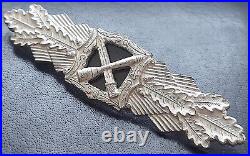
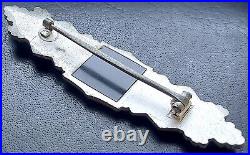
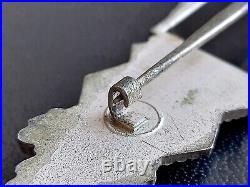
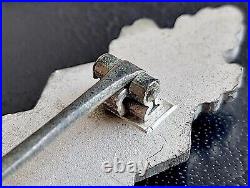
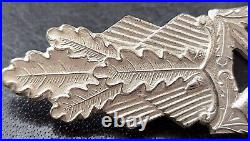
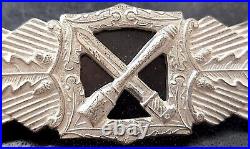
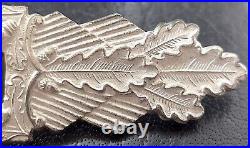
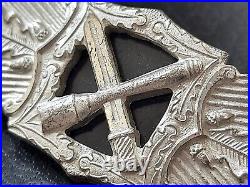
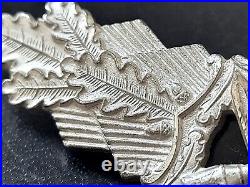
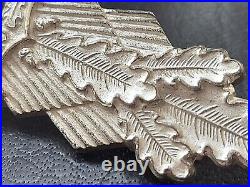
Original German post WW2 / 1957 pattern Close Combat Clasp in Silver (Nahkampfspange in Silber), IN PERFECT CONDITION, INTACT PIN DEVICE, MAKER: STEINHAUER UND LUECK (ST&L), GOOD DETAILED LATER EXAMPLE WITH OPEN HINGE BLOCK. FEW FACTS ABOUT THE 1957 PATTERN GERMAN AWARDS. In 1957 the West German government authorised replacement Iron Crosses with an Oak Leaf Cluster in place of the swastika, similar to the Iron Crosses of 1813, 1870, and 1914, which could be worn by World War II Iron Cross recipients. The 1957 law also authorised de-Nazified versions of most other World War II-era decorations (except those specifically associated with Nazi Party organizations, such as SS Long Service medals, or with the expansion of the German Reich, such as the medals for the annexation of Austria, the Sudetenland, and the Memel region). The main government contract to manufacture and supply these new de-nazified WW2 1957 official decorations went to the world famous German firm Steinhauer & Lueck, Luedenscheid Germany. Knights Crosses, Iron Crosses, Wound Badges, Tank Assault Badges etc were re-designed by Steinhauer & Lück – often with the oak-leaf spray replacing the swastika, with S&L having the sole patent rights to all WW2 1957 German decorations. S&L did not have the whole monopoly on medal making, other famous firms such as Deschler & Sohn, BH Maher and Juncker also manufactured these new German decorations. Lüdenscheid is situated between the cities Dortmund and Bonn. It was here that one of the youngest medal firms was founded in 1889 by August Steinhauer and Gustav Adolf Lück. The first production began in a cellar, the customer base continued to increase. A property was bought at 51 Hochstrasse which is still home for this famous company today. During WW2 Steinhauer & Lück produced medals and badges, like the famous Knights Cross and many other types of medals and badges. In 1957 this company was awarded the contract to produce all the newly re-designed legal WW2 1957 de-nazified decorations, plus the contract to manufacture all of Germany’s official decorations including Germany’s highest order the Bundesverdienstkreuz. Only a very limited number of original WW2 1957 medals are still produced, mainly Iron Crosses, German Cross Gold & Silver & Wound Badges and are considered 100% genuine by the German Government. HISTORY OF THE AWARD. Heer Close Combat Bar was instituted on November 25, 1942, in order to recognize the courage of the German soldier in hand-to-hand combat. This award was completely independent of the Infantry Combat Badge. The badge designed by Wilhelm Ernst Peekhaus of Berlin (his name preceded by FEC can be found on the reverse of some examples), and was instituted in three classes, bronze, silver, and gold. The badge is die cast and generally manufactured in zinc, though examples in tombac or aluminum are also found.. It is slightly convex, with the center piece consisting of the national emblem surmounting a crossed bayonet and hand grenade. This piece is cut out and backed with a flat square of blackened steel (magnetic), crimped in place on the reverse. The pin is always broad in the center and tapering at the end. The bar varies in length from between 95 to 97.5mm, and in height from between 25 to 27mm according to the Juncker, JFS and F&BL types. Presentation of the badge was made by the company, Battalion or Regimental Commander (or equivalent). On March 26, 1944, A. Reserved the right to personally present the close combat bar in gold as “the highest infantry decoration”. On August 30, 1944, the gold class recipients were automatically presented the German cross in gold and were permitted to spend 21 days at home. The Close Combat Badge decoration was to be worn 1 centimeter above the ribbon bar or mounted group. When more than one grade was presented to the same individual, only the highest grade was to be worn (though the recipient kept all grades in his possession). An award document was given to the soldier (different types exist, it depending on the unit), and there was an entry in his Soldbuch attended with a detailed list of his combat days (unit, date, location). The close combat bar was presented in a cardboard box or in celluloid. The badge was presented based on the number of combat days as follows: Bronze class for 15 combat days, Silver class for 30 combat days, Gold class for 50 combat days. Criteria for a combat day was as follows. All combat days in which the soldier had the opportunity to be close enough to “see the white of the enemy’s eyes”, use close combat weapons to assault the enemy man-to-man and be victorious. Days in which the soldier was part of a mayor attack or assault, reconnaissance attack, defense of a position, or single messenger run. These actions could take place in the front line or in the rear (against Partisans). The initial combat days were established taking in count the uninterrupted time of engagement on the Eastern front since June 22 of 1941, or in Africa since March 26 of 1943: 15 months = 15 combat days, 12 months = 10 combat days, 8 months = 5 combat days. This decoration was also awarded posthumously, in which case both decoration and certificate were sent to the next of kin. The Division commander was also able authorize the award to a wounded soldier who, because of permanent injury, would no longer have the opportunity to complete the minimum days, provided he completed the following: Bronze Class – 10 days minimum, Silver Class – 20 days minimum, Gold Class – 40 days minimum. The Close Combat Bar was also awarded to members of the Luftwaffe, though it would later replaced by the Luftwaffe Close Combat Bar (Few is known about this badge, and no picture exist of its wear). This article be not complete without a mention of the gold bar presentation. According to Manfred Dörr’s book on this subject, about 600 gold bar were awarded. The bar was in every respect the same design than the other classes, but gilded – a special fire gilded badge does exist. This badge was presented during an official ceremony. This item is in the category “Collectables\Militaria\World War II (1939-1945)\Medals/ Ribbons”. The seller is “a..anderson” and is located in this country: GB. This item can be shipped worldwide.
- Type: Badges
- Conflict: World War II (1939-1945)
- Era: 1945-Present
- Country/ Organization: Germany
- Theme: Militaria
- Service: Army
- Featured Refinements: Miniature Medal
- Country/Region of Manufacture: Germany